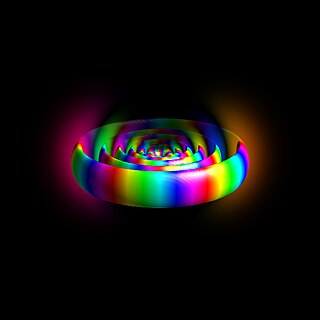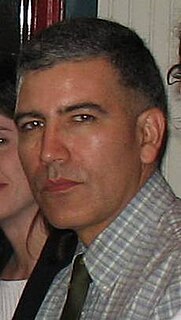Related Research Articles
Wave–particle duality is the concept in quantum mechanics that every particle or quantum entity may be described as either a particle or a wave. It expresses the inability of the classical concepts "particle" or "wave" to fully describe the behaviour of quantum-scale objects. As Albert Einstein wrote:
It seems as though we must use sometimes the one theory and sometimes the other, while at times we may use either. We are faced with a new kind of difficulty. We have two contradictory pictures of reality; separately neither of them fully explains the phenomena of light, but together they do.
In quantum mechanics, counterfactual definiteness (CFD) is the ability to speak "meaningfully" of the definiteness of the results of measurements that have not been performed. The term "counterfactual definiteness" is used in discussions of physics calculations, especially those related to the phenomenon called quantum entanglement and those related to the Bell inequalities. In such discussions "meaningfully" means the ability to treat these unmeasured results on an equal footing with measured results in statistical calculations. It is this aspect of counterfactual definiteness that is of direct relevance to physics and mathematical models of physical systems and not philosophical concerns regarding the meaning of unmeasured results.
In physics, the correspondence principle states that the behavior of systems described by the theory of quantum mechanics reproduces classical physics in the limit of large quantum numbers. In other words, it says that for large orbits and for large energies, quantum calculations must agree with classical calculations.

A Rydberg atom is an excited atom with one or more electrons that have a very high principal quantum number, n. The higher the value of n, the farther the electron is from the nucleus, on average. Rydberg atoms have a number of peculiar properties including an exaggerated response to electric and magnetic fields, long decay periods and electron wavefunctions that approximate, under some conditions, classical orbits of electrons about the nuclei. The core electrons shield the outer electron from the electric field of the nucleus such that, from a distance, the electric potential looks identical to that experienced by the electron in a hydrogen atom.

In classical mechanics, anharmonicity is the deviation of a system from being a harmonic oscillator. An oscillator that is not oscillating in harmonic motion is known as an anharmonic oscillator where the system can be approximated to a harmonic oscillator and the anharmonicity can be calculated using perturbation theory. If the anharmonicity is large, then other numerical techniques have to be used.
Oleg Dmitrovich Jefimenko was a physicist and Professor Emeritus at West Virginia University.
The Mechanical Universe...And Beyond is a 52-part telecourse, filmed at the California Institute of Technology, that introduces university level physics, covering topics from Copernicus to quantum mechanics. The 1985-86 series was produced by Caltech and INTELECOM, a nonprofit consortium of California community colleges now known as Intelecom Learning, with financial support from Annenberg/CPB.
In physics, a photon gas is a gas-like collection of photons, which has many of the same properties of a conventional gas like hydrogen or neon – including pressure, temperature, and entropy. The most common example of a photon gas in equilibrium is black-body radiation.
Superfluidity and superconductivity are macroscopic manifestations of quantum mechanics. There is considerable interest, both theoretical and practical, in these quantum phase transitions. There has been a tremendous amount of work done in the field of phase transitions and critical phenomena in two dimensions. Much of the interest in this field is because as the number of dimensions increases, the number of exactly solvable models diminishes drastically. In three or more dimensions one must resort to a mean field theory approach. The theory of superfluid transitions in two dimensions is known as the Kosterlitz-Thouless (KT) theory. The 2D XY model - where the order parameter is characterized by an amplitude and a phase - is the universality class for this transition.
Injection locking and injection pulling are the frequency effects that can occur when a harmonic oscillator is disturbed by a second oscillator operating at a nearby frequency. When the coupling is strong enough and the frequencies near enough, the second oscillator can capture the first oscillator, causing it to have essentially identical frequency as the second. This is injection locking. When the second oscillator merely disturbs the first but does not capture it, the effect is called injection pulling. Injection locking and pulling effects are observed in numerous types of physical systems, however the terms are most often associated with electronic oscillators or laser resonators.
In spectroscopy, oscillator strength is a dimensionless quantity that expresses the probability of absorption or emission of electromagnetic radiation in transitions between energy levels of an atom or molecule. The oscillator strength can be thought of as the ratio between the quantum mechanical transition rate and the classical absorption/emission rate of a single electron oscillator with the same frequency as the transition.
Quantum dissipation is the branch of physics that studies the quantum analogues of the process of irreversible loss of energy observed at the classical level. Its main purpose is to derive the laws of classical dissipation from the framework of quantum mechanics. It shares many features with the subjects of quantum decoherence and quantum theory of measurement.

Francisco Javier "Frank" Duarte is a laser physicist and author/editor of several well-known books on tunable lasers and quantum optics. He introduced the generalized multiple-prism dispersion theory, has discovered various multiple-prism grating oscillator laser configurations, and pioneered polymer-nanoparticle gain media. His contributions have found applications in a variety of fields including astronomical instrumentation, atomic vapor laser isotope separation, geodesics, gravitational lensing, laser medicine, laser microscopy, laser pulse compression, laser spectroscopy, nonlinear optics, and tunable diode lasers.

Cavity optomechanics is a branch of physics which focuses on the interaction between light and mechanical objects on low-energy scales. It is a cross field of optics, quantum optics, solid-state physics and materials science. The motivation for research on cavity optomechanics comes from fundamental effects of quantum theory and gravity, as well as technological applications.

The Quantum Vacuum: An Introduction to Quantum Electrodynamics is a physics textbook authored by Peter W. Milonni in 1993. The book provides a careful and thorough treatment of zero-point energy, spontaneous emission, the Casimir, van der Waals forces, Lamb shift and anomalous magnetic moment of the electron at a level of detail not found in other introductory texts to quantum electrodynamics.

Classical Electrodynamics is a textbook about that subject written by theoretical particle and nuclear physicist John David Jackson. The book originated as lecture notes that Jackson prepared for teaching graduate-level electromagnetism first at McGill University and then at the University of Illinois at Urbana-Champaign. Intended for graduate students, and often known as Jackson for short, it has been a standard reference on its subject since its first publication in 1962.

Quantum Computation and Quantum Information is a textbook about quantum information science written by Michael Nielsen and Isaac Chuang, regarded as a standard text on the subject. It is informally known as "Mike and Ike", after the candies of that name. The book assumes minimal prior experience with quantum mechanics and with computer science, aiming instead to be a self-contained introduction to the relevant features of both. The focus of the text is on theory, rather than the experimental implementations of quantum computers, which are discussed more briefly.
Electricity and Magnetism is a standard textbook in electromagnetism originally published by Nobel laureate Edward Mills Purcell in 1963. Along with David Griffiths' Introduction to Electrodynamics, the book is one of the most widely adopted undergraduate textbooks in electromagnetism. A Sputnik-era project funded by an National Science Foundation grant, the book is influential for its use of relativity in the presentation of the subject at the undergraduate level. The 1965 edition, now freely available due to a condition of the federal grant, was originally published as a volume of the Berkeley Physics Course. A revised an updated version of the book was published posthumously by David J. Morin and Cambridge University Press in 2013, and is known colloquially as Purcell and Morin.
References
- ↑ Frank, Winfried; von Brentano, Peter (1994). "Classical analogy to quantum mechanical level repulsion". American Journal of Physics. 62 (8): 706–709. doi:10.1119/1.17500. ISSN 0002-9505.
- ↑ Novotny, Lukas (2010). "Strong coupling, energy splitting, and level crossings: A classical perspective". American Journal of Physics. 78 (11): 1199–1202. doi:10.1119/1.3471177. ISSN 0002-9505.
| This quantum mechanics-related article is a stub. You can help Wikipedia by expanding it. |